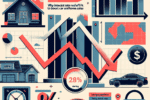Beijing, China – Economic data released in China over the past month painted a picture of weak confidence continuing to hinder growth in the world’s second-largest economy. Most indicators fell short of market expectations, pointing to both the private sector and households remaining cautious.
Credit data revealed that aggregate financing saw its first decline since 2005, while M2 growth hit record lows. This contraction came after a strong 2023, leading to speculation that real interest rates were too high for the current economic conditions. The likelihood of monetary easing in the coming months has increased as a result.
Retail sales also reflected consumer caution, dropping to a new post-pandemic low of 2.3% year-on-year. Consumers showed reluctance towards big-ticket purchases, preferring to spend on “eat, drink, and play” categories. Fixed asset investment disappointed as well, with a meager 4.2% year-on-year growth, primarily due to a lackluster performance in private sector investment.
Nevertheless, amid the downturn, China’s transition towards high-tech development offered a glimmer of hope. Industrial activity showed signs of recovery, with industrial production rising to 6.7% year-on-year in April. Sectors like high-tech manufacturing, computers, communications, and auto industries experienced robust growth. While conflicting signs emerged in May’s manufacturing PMI data, areas like AI-related demand continued to drive imports, suggesting ongoing growth opportunities in the tech sector.
Policy measures implemented to stabilize the economy included removing mortgage rate floors, reducing downpayment ratios, and easing purchase restrictions. Measures like direct housing purchases aimed to absorb excess inventories and support struggling property developers. The increased policy support contributed to market stability and signaled a commitment to economic growth.
Looking ahead, the Third Plenum meeting in July is expected to outline further policy directions for reforms and modernization in China. President Xi’s comments hinted at measures to support property, employment, and childcare. Despite challenges, there is growing optimism that housing prices in major cities could stabilize in the near future, providing a ray of hope for China’s economic recovery.










